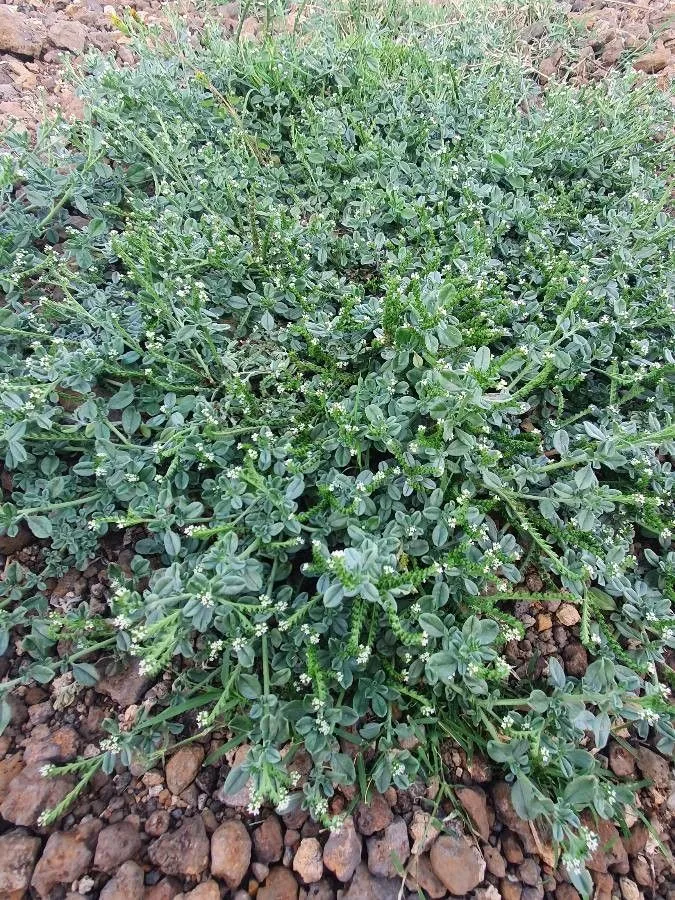
Author: L.
Bibliography: Sp. Pl.: 130 (1753)
Year: 1753
Status: accepted
Rank: species
Genus: Heliotropium
Vegetable: False
Observations: EC. & S. Europe to Africa, W. Asia to Indian Subcontinent
Prostrate heliotrope, scientifically known as Heliotropium supinum, is a notable member of the Boraginaceae family. Described in “Species Plantarum” in 1753 by Carl Linnaeus, one of the foremost figures in botanical nomenclature, this plant has since intrigued botanists and horticulture enthusiasts alike.
Native to a wide geographical range, Prostrate heliotrope can be found in diverse habitats from Eastern and Southern Europe extending to Africa and further into Western Asia, stretching all the way to the Indian Subcontinent. This considerable distribution highlights the adaptability and resilience of the species to various climatic conditions and soil types.
Prostrate heliotrope typically presents itself as a low-lying, sprawling plant, staying true to its common name. Its growth habit, characterized by close-to-the-ground foliage, allows it to effectively cover and stabilize the ground, making it a beneficial addition for erosion control. The plant’s small, delicate flowers often exhibit shades of white or lavender, adding understated beauty to its surroundings. These blooms also attract a variety of pollinators, thus playing a role in supporting local ecosystems.
Culturally and historically significant in various regions, Prostrate heliotrope may have been used in traditional practices, although specific ethnobotanical uses may vary depending on the locality. Its presence across continents indicates that it has been both ecologically and anthropologically important through time.
Whether observed in its native habitat or cultivated in gardens around the world, Heliotropium supinum continues to capture attention for its ecological role and subtle charm. Understanding and preserving such species not only helps maintain biodiversity but also enriches our understanding of the botanical wonders around us.
Eng: dwarf heliotrope, prostrate heliotrope, spreading heliotrope
Spa: hierba de alacran
Deu: niedrige sonnenwende
En: Prostrate heliotrope, Spreading heliotrope, Dwarf heliotrope
Ar: رحب (رَحَب)، رحابه (رَحابَه، رُحابه), غبيره (غُبِّيره، غُبَّيره)، رحى (رَحى), كديه(كُديّه)، زريقه(زُريْقه)، شوك الضَبْع
Fr: Héliotrope couché
De: Niedrige Sonnenwende, Niederliegende Sonnenwende
He: עוקץ-עקרב שרוע
It: Eliotropio peloso
Es: Hierba de alacran
Taken Aug 15, 2022 by vince Lhypno (cc-by-sa)
Taken Jun 12, 2020 by Shankar Ratiney (cc-by-sa)
Taken Aug 24, 2020 by Sánchez SV Víctor Julio (cc-by-sa)
Taken Oct 12, 2021 by S100 (cc-by-sa)
Taken Oct 5, 2022 by ESPOIR ANDJI (cc-by-sa)
Taken Oct 15, 2016 by Photoflora – Jean-Luc TASSET (©)
Taken Sep 28, 2021 by offline ad (cc-by-sa)
Taken Sep 21, 2022 by Nasser Benchiha (cc-by-sa)
Taken Sep 4, 2022 by Luís García (cc-by-sa)
Taken Oct 25, 2020 by susan brown (cc-by-sa)
Taken Oct 15, 2015 by Photoflora – Benoit BOCK (©)
Taken Oct 15, 2015 by Photoflora – Benoit BOCK (©)
Taken Oct 25, 2020 by susan brown (cc-by-sa)
Taken Sep 1, 2003 by Tela Botanica − Errol VELA (cc-by-sa)
Taken Sep 1, 2003 by Tela Botanica − Errol VELA (cc-by-sa)
© copyright of the Board of Trustees of the Royal Botanic Gardens, Kew.
© copyright of the Board of Trustees of the Royal Botanic Gardens, Kew.
© copyright of the Board of Trustees of the Royal Botanic Gardens, Kew.
Taken Oct 19, 2022 by Stefana Popova (cc-by-sa)
Taken Oct 28, 2021 by Arsham Hekmat (cc-by-sa)
Taken Oct 25, 2020 by susan brown (cc-by-sa)
Taken Oct 25, 2020 by susan brown (cc-by-sa)
Taken Oct 12, 2021 by S100 (cc-by-sa)
Taken Oct 15, 2015 by Photoflora – Benoit BOCK (©)
Taken Oct 15, 2016 by Photoflora – Jean-Luc TASSET (©)
Taken Oct 15, 2016 by Photoflora – Jean-Luc TASSET (©)
Taken Oct 15, 2019 by Photoflora – Jean-Luc TASSET (©)
Taken Jan 1, 1970 by Photoflora – L’Abbé COSTE (©)
Taken Oct 15, 2015 by Photoflora – Benoit BOCK (©)
Growth habit>: Forb/herb
Ph maximum: 7.0
Ph minimum: 6.5
Light: 9
Atmospheric humidity: 7
Bloom months: [‘jun’, ‘jul’, ‘aug’, ‘sep’]
Soil nutriments: 4
Family: Myrtaceae Author: (F.Muell.) K.D.Hill & L.A.S.Johnson Bibliography: Telopea 6: 402 (1995) Year: 1995 Status:…
Family: Rubiaceae Author: Pierre ex A.Froehner Bibliography: Notizbl. Bot. Gart. Berlin-Dahlem 1: 237 (1897) Year:…
Family: Sapindaceae Author: Koidz. Bibliography: J. Coll. Sci. Imp. Univ. Tokyo 32(1): 38 (1911) Year:…
Family: Asteraceae Author: A.Gray Bibliography: Pacif. Railr. Rep.: 107 (1857) Year: 1857 Status: accepted Rank:…
Family: Fabaceae Author: Medik. Bibliography: Vorles. Churpfälz. Phys.-Ökon. Ges. 2: 398 (1787) Year: 1787 Status:…
Family: Aspleniaceae Author: (Cav.) Alston Bibliography: Bull. Misc. Inform. Kew 1932: 309 (1932) Year: 1932…